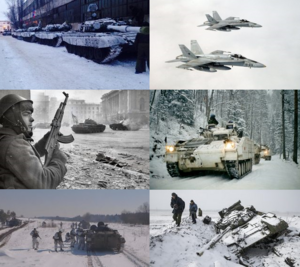2005 Polnitsan War: Difference between revisions
Arthurista (talk | contribs) mNo edit summary |
Arthurista (talk | contribs) mNo edit summary |
||
| Line 21: | Line 21: | ||
| territory = | | territory = | ||
| result = Coalition victory. Polnitsan reunification and merger with [[Garima]] | | result = Coalition victory. Polnitsan reunification and merger with [[Garima]] | ||
| combatant1 = {{flag|North Polnitsa|north}} | | combatant1 = {{flag|North Polnitsa|north}}<br>'''Supported by:''' {{flag|Valgtea}} | ||
| combatant2 = {{flag|South Polnitsa}}<br>{{flag|Latium}}<br> {{flag|Garima}}<br>{{flag|Arthurista}}<br>{{flag|Drevstran}} (naval forces only)<br>{{flag|Yisrael}} (aerial forces largely) | | combatant2 = {{flag|South Polnitsa}}<br>{{flag|Latium}}<br> {{flag|Garima}}<br>{{flag|Arthurista}}<br>{{flag|Drevstran}} (naval forces only)<br>{{flag|Yisrael}} (aerial forces largely) | ||
| commander1 = TBD | | commander1 = TBD | ||
Revision as of 01:14, 29 March 2020
This article is incomplete because it is pending further input from participants, or it is a work-in-progress by one author. Please comment on this article's talk page to share your input, comments and questions. Note: To contribute to this article, you may need to seek help from the author(s) of this page. |
| 2005 Polnitsan War | |||||||
|---|---|---|---|---|---|---|---|
 Clockwise: the North Polnitsan invasion of South Polnitsa, Latin Air Force Ifrits during the war, Arthuristan paratroopers during Operation Daffodil, South Polnitsan Special Forces passing destroyed Northern armour, North Polnitsan artillery in action, street fighting during the North Polnitsan Revolution | |||||||
| |||||||
| Belligerents | |||||||
|
Supported by: Template:Country data Valgtea |
| ||||||
| Commanders and leaders | |||||||
| TBD | TBD | ||||||
| Strength | |||||||
| 55,000 | 20,000 (ground forces during Operation Daffodil) | ||||||
| Casualties and losses | |||||||
| Circa 10,000 military casualties during Operation Daffodil | Circa 67 killed and 410 wounded during Operation Daffodil | ||||||
The 2005 Polnitsan War was a ten-week undeclared war fought in early-2005 between the forces of socialist North Polnitsa, on the one hand, and a coalition of nations opposed to it on the other. North Polnitsa, supported by Valgtea, invaded South Polnitsa on Christmas Day of 2004 in an attempt to forcibly unify the divided nation, swiftly defeating all opposition and occupying the country. At the same time, Valgtea mobilised its forces along the border with Garima in an attempt to dissuade Gariman intervention in the Polnitsan situation. In response, the South Polnitsan monarchy and government in exile, as well as the Gariman government, called for international assistance in liberating the occupied country. Over the next several weeks, land forces from Arthurista and Latium were deployed in Garima, in preparation for a battle to eject the occupying North Polnitsan forces. A four-brigade ‘Multinational Division’, roughly 20,000 in total in manpower terms, was established in order to coordinate the coalition’s ground troops.
After satisfying themselves that further diplomatic efforts were fruitless, the governments of the coalition granted final political sanction for Operation Daffodil. The plan entailed the Multinational Division, backed by the extensive use of air power, breaking through screening North Polnitsan Forces and dashing along the North-South Polnitsa border for the shore of Lake Kupalnista, thereby cutting off and surrounding the entire North Polnitsan Army. Over the course of the 96-hour ground campaign, the four coalition brigades defeated three divisions of North Polnitsan troops and for all intents and purposes destroyed it as a viable military force. North Polnitsan units cut off in the occupied south surrendered en masse to the Multinational Division.The North Polnitsan squadron on Lake Kupalnista was also engaged and destroyed by the Drevstranese Navy.
News of the defeat triggered the North Polnitsan Revolution, which led to the overthrow of the socialist one-party government and, in a referendum, reunification with South Polnitsa and the eventual merger with Garima. In Valgtea, the defeat of North Polnitsa constituted a major humiliation and greatly damaged its international prestige, leading to its relative decline in the subsequent ‘Decade of Chaos’, as well as triggering far-reaching military, political and economic reforms.